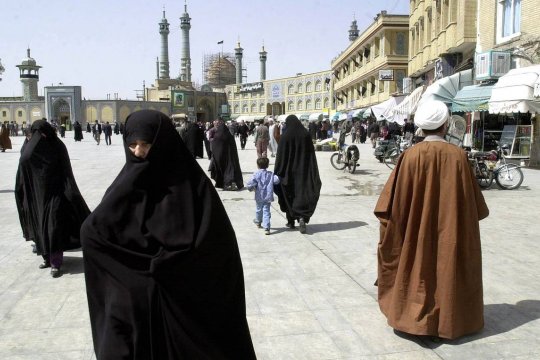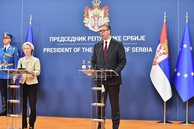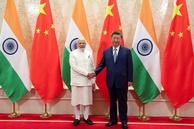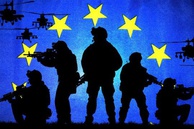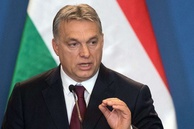The world media is abuzz with news about the presidential elections in the United States, the fighting in and around Nagorno-Karabakh and the upcoming second wave of the COVID-19 epidemic. That being said, the situation in Syria remains very much in the focus of attention of analysts and political scientists.
Recently, against the backcloth of the developments in Syria, media outlets have increasingly been discussing issues pertaining to relations between Russia and the Islamic Republic of Iran (IRI).
It is no secret that Iran was the first country to join the civil war in Syria that erupted in 2011. It was Tehran that provided emergency assistance to President Bashar Assad, preventing his overthrow by the opposition forces. What happened next did not unfold in a way Tehran expected though.
By the summer of 2014, The Islamic State terrorist organization (aka IS, ISIS, Daesh – all banned in Russia) had taken control of the eastern part of the country, announcing the creation of a caliphate in parts of Syria and Iraq with its capital in Raqqa.
In 2015, the Syrian government forces, the military contingent of Iran’s Islamic Revolutionary Guard Corps (IRGC), led by General Qasem Soleimani, the Lebanese Hezbollah, as well as the pro-Iranian multinational Shiite formations suffered a series of serious setbacks putting in question the very existence of President Assad’s regime
Trying to save the situation, General Soleimani pays two visits to Moscow in late July and early August 2015, to discuss the situation in Syria. (1)
Shortly after, Russia receives an official request for assistance from Damascus, and on September 30, the Russian Aerospace Forces launch military operations against ISIS terrorists, and ultimately crush the terrorist groups in Syria and preserve the country’s sovereign status.
In view of the anti-terrorist forces’ successes in Syria, Russian President Vladimir Putin said it was now time to withdraw all foreign armed forces from Syria.
“We believe that after the Syrian armed forces’ significant victories in the fight against terrorism, and with the start of a more active phase of the political process there, foreign armed forces will be withdrawn from the territory of the Syrian Arab Republic,” President Putin said when meeting with Bashar Assad in Sochi on May 17, 2018. (2)
Putin’s statement caused a mixed reaction in Tehran, with Foreign Minister Mohammad Javad Zarif stating that Iranian forces were in Syria with the official permission of the authorities, and hinted that Tehran was not going to leave the Syrian territory, adding that it was too important for Iran geopolitically.
Russia views Syria as a multinational, multi-confessional, and at the same time a secular state, which maintains friendly relations with Moscow and respects its interests both in that country and in the Middle East as a whole (including the Russian air force base in Khmeimim and the naval station in Tartus.) Equally important for Russia is the fact that Syria has normal relations with its neighbors, primarily Israel and Turkey. With the destruction of the Islamic State organization, Moscow believes that the formation of a "new Syria" can only be ensured by peaceful means through activating the constitutional process that would involve all interested parties, including those opposed to Bashar Assad, whose continued stay in power is not something Russia will necessarily insist on in the future.
Meanwhile, with the work of the Syrian Constitutional Committee facing serious hurdles due to the deep divisions among its members, President Assad remains the only symbol of Syrian statehood. Moscow is fully aware of this and despite various views about Bashar Assad’s political future, is making every effort possible to strengthen Syria’s sovereign status. Armed forces subordinate to a legitimate leadership are a very important factor of sovereignty and statehood, and in this sense Russia has done a lot for Syria and its future.
During the five years of its presence in Syria, Russia has been working hard to reorganize, modernize and equip the Syrian army, improving its professional level, restoring the chain of command and combat readiness. Russia also helped with the formation, training and equipment of the 4th and 5th corps of the Syrian army, helped reorganize the "Power of the Tigers" elite unit, which scored numerous victories over the terrorists. This means that by reviving the armed forces subordinate exclusively to the Syrian state, Russia strengthened not the regime of Bashar Assad, but the Syrian statehood.
Iran, for its part, sees Syria as an outpost in its strategic struggle against Israel and "misguided Muslim regimes that have sold themselves out to world Zionism and American imperialism." Tehran has made huge human and material sacrifices to erect this “fortress,” losing during its the nine-year participation in the Syrian war thousands of its fighters, including 11 generals. In addition, since 2011, Tehran has reportedly spent between $5 billion and $20 billion annually in assistance to Damascus. (3)
Iran is paying such a high price in Syria for a reason, however, since it views the Arab country as a "golden link" - a term proposed by Ali Akbar Velayati, the foreign policy adviser to Iran’s Supreme Leader - in a Shiite chain stretching from Iran westward across Iraq, Syria and Lebanon to the Mediterranean Sea. This chain is also called the "Shiite belt" or "axis of resistance" (apparently to the United States and Israel). As Brigadier General Amir Ali Hajizadeh, Commander of the Aerospace Forces of the IRGC, explained very frankly, “all members of the 'Axis of Resistance' are united, and we must join together to withdraw the American forces from the region and destroy the Zionist regime ... Iran stretches from the Red Sea to the Mediterranean and from Ansar Allah in Yemen to Hezbollah in Lebanon.” (4)
For Iran, the loss of Syria would mean a rupture of this "axis of resistance," the loss of land routes to Lebanon and to its creation, Hezbollah, it would mean the loss of control over the Syrian-Israeli border, a serious loss of credibility among Shiite groups in the Middle East, and, in general, a weakening of Tehran's positions in the region.
Tehran intensified its activity in Syria following the destruction of the main terrorist forces, working on several tracks.
First, Iran has deployed in Syria the elite units of the Quds Special Forces, which are part of the IRGC and are fighting on the ground. Their officers also act as commanders of Shiite groups (5), as well as instructors and advisers to pro-Iranian armed formations subordinate to Damascus.
The Iranian-controlled Lebanese Hezbollah is the largest and most combat-ready of the Shiite organizations, boasting significant resources, including its own army, financial structures, and a large network of representative offices in the region. Hezbollah is one of the most powerful actors in the Syrian conflict.
In Syria, the Iranians are establishing their military bases in the most strategic areas and building warehouses with weapons, ammunition and material and technical means.
The IRGC is setting up all kinds of staging posts and warehouses for Hezbollah, which accumulate and store weapons and ammunition, including for further transportation to Lebanon. This is often done close to Russian military installations in order to secure against military strikes by Israel, which is also active in the region against Iranian military units, primarily Hezbollah. Tehran knows that the Israelis will not launch missile and airstrikes on Russian servicemen and thus ensures the security of its facilities.
In its efforts to rebuild the Syrian armed forces, Iran, unlike Russia, is creating parallel non-state military structures not directly subordinate to Damascus, but answering to “pro-Iranian” Syrians or directly to IRGC officers. The Iranians are also trying to establish closest possible contacts with the Syrian army by offering the services of their commanders. The 4th Division is exactly one such formation.
Secondly, Iran is exercising a large-scale economic expansion in Syria, with its representatives actively buying real estate, various industrial enterprises (even those damaged by war), and land.
Deals are made either for Iranians or Syrians, representing Tehran’s interests in Syria – primarily Shiites and, to a lesser extent, Alawites. For example, in the capital Damascus, one can see a lot of advertisements and shop signs in Persian (Farsi). Iran is most actively expanding its presence in many of Syria’s economic sectors.
Thirdly, this is certainly an ideological expansion. The Iranians are actively promoting Shia principles among the Syrian population. Converting Sunnis to Shiites may not be easy, but in principle, it is possible. Before the events of 2010-2011, Syria was not a very religious country. Therefore, Syrians without any clear religious affiliation are the primary objects of Shiite proselytizing. Moreover, the Iranians are actively handing out various economic and financial privileges to many Syrian demographics, above all Alawites and Shiites, in the form of humanitarian aid, and carry out large-scale propaganda and PR work, and with good results too.
The Iranians enjoy strong positions in the highest echelons of the country’s military-political establishment, including members of President Assad’s inner circle and his security services. A prominent role here is played by Assad's younger brother, Maher, a pro-Iranian politician, who commands many in Syria’s security forces.
As for Turkey, Sunni Arab countries, the United States and Israel, they are all wary of Tehran's policy towards Syria.
Iran and its satellites see Israel as their main adversary in the region. For Russia, Israel is a reliable partner with the two countries having shared views on many aspects of the Syrian problem. So, shortly before the start of the Russian aerial campaign in Syria (September 30, 2015), Russia and Israel set up a special coordination center to ensure interaction between their militaries in this region.
Russia and Israel maintain close political and economic ties, including permanent contacts at the very top, interaction in the war on terror, in the field of security and intelligence, in the military-technical sphere and in space exploration. In 2019, Russia’s trade with the Jewish State stood at $2.25 billion (6), while with Iran - only $ 1.59 billion. (7) Incidentally, Israel has a population of just 9.1 million, compared to 83.1 million in Iran.
Humanitarian ties between Russians and Israelis are also developing fast. And with good reason too, since there are around one million Jews currently living in Russia, while in Israel, Russian-speakers (immigrants from the former Soviet Union), according to various estimates, account for between 15 percent to 25 percent of the country’s 9.1-million-strong population. The countries also have a visa-free regime.
For several years now, Israeli warplanes have been striking Iranian and Hezbollah installations in Syria about once a week. When this happens, Russian air defenses do not fire at Israeli combat aircraft because Moscow wants to avoid an escalation of the conflict.
Russia is contributing heavily to the reduction of tensions between Israel on the one side and Iran and its satellites on the other. In September, Lebanese Hezbollah units were said to be leaving Syria in what observers said was the result of tacit agreements between Moscow, Tehran, Damascus and Ankara (8). There were objective reasons - mainly the tense political situation in Lebanon – that necessitated Hezbollah’s pullout from Syria, of course, but there is no denying Russia’s positive role in this.
Moscow also negotiated with Damascus and Tehran the withdrawal of pro-Iranian militias and armed units from southern Syria from the border with Israel and their replacement with pro-Russian units. In practice, this never happened though.
The Iranians and their supporters regard their presence in southern Syria near the Israeli border as a strategic asset in their standoff with the Jewish State since the Syrian-Israeli border is a very important psychological barrier in the Iranian-Israeli confrontation.
Even though there is no serious confrontation between Moscow and Tehran in Syria, of course, the past few years have seen occasional clashes between pro-Russian and pro-Iranian security forces there. However, this certainly can’t lead to a direct regional confrontation between Russia and Iran.
Many factors of Iran’s presence in Syria raise a lot of questions. This is clearly demonstrated by the interview that the former head of the Russian Reconciliation Center (2016), retired Lieutenant General Sergei Chvarkov, gave to RIA Novosti.
“In August 2018, Damascus and Tehran signed an agreement on military cooperation, which provides for Iran's assistance in rebuilding the Syrian defense industry and the country's infrastructure,” Sergei Chvarkov pointed out. “When implemented, the agreement can, on the one hand, strengthen the Iranians’ positions in Syria and further Assad regime’s dependence on Tehran. On the other hand, Iranian financing of Shiite groups and attempts to spread Shiism in originally Sunni territories can stoke up tensions with the Sunnis and Kurds inside Syria. Any further large-scale Iranian penetration into Syria will create a number of serious obstacles to the advancement of reforms and the development of the political process in Syria, and complicate relations with Israel, the United States, Turkey and the Sunni Arab countries. This will complicate the task of finding alternative foreign sources for rebuilding the country, since the efforts by Iran and Russia will clearly not be enough."(10)
Here we will interrupt General Chvarkov and recall the words of President Assad, who said that the restoration of the infrastructure of the Syrian Arab Republic would cost around $400 billion, which, according to his estimates, will take from 10 to 15 years. (11) Experts put the cost of rebuilding the country at $1.2 trillion. (12) A colossal amount of money that will prove hard to line up even by joint efforts of many countries.
“And the lack of funds will prevent achieving any visible success in restoring the country’s infrastructure, moving forward the political process, bringing back the refugees and reforming the army and special services,” General Chvarkov continues. “Moreover, the expansion of Iran's influence in Syria will rule out the lifting of the US-imposed sanctions and prevent the supply of modern technologies and equipment needed to restore the economy and virtually all other spheres of state activity in Syria.” (13)
Talking about the future, experts on Syria and Iran argue that Tehran is unlikely to exit Syria anytime soon. As General Chvarkov emphasized, “the fact that Iran has come to Syria to stay is evidenced by the treaties that have recently been signed between Syria and Iran. (14)
Well, Iran could possibly withdraw from Syria in case of a serious deterioration in the socio-economic situation back home. Tehran could indeed pull out some of its units - primarily Shiite ones, but in any case, Iran’s political, military, economic and ideological influence in Syria will not go anywhere.
The views of the author are his own and may differ from the position of the Editorial Board.
-------------------------------------------------------------------------------
- Maria Baranova.The Iranian who brought Russia to Syria. Ru. 29,09.2016. https://www.gazeta.ru/politics/2016/09/29_a_10222325.shtml#page2; Qasem Soleimani. Who was the general, who persuaded Putin to goto Syria. BBC 03.01.2020. https://www.bbc.com/russian/news-50981883
- Putin and Assad held talks RIA Novosti. 05.2018. https://ria.ru/20180517/1520804238.html
- Sergei Chvarkov: Over 5 years Russia restored the Syrian army’s combat readiness. Retired Lt.-General Sergei Chvarkov’s interview with RIA Novosti. RIA Novosti homepage. 09.2020. https://ria.ru/20200930/siriya-1577948800.html
- Iran mobilizes “axis of resistance” to squeeze the US out of the Middle East. Eurasia Daily (EADaily). 16.02.2020. https://eadaily.com/ru/news/2020/02/16/iran-mobilizuet-os-soprotivleniya-na-vydavlivanie-ssha-s-blizhnego-vostoka
- The list of Shiite militant formations, collected from all over the world by voluntary-compulsory method, has more than 30 units. Their qualitative and quantitative composition is different, but they all underwent training under the auspices of the Iranians, and are now controlled and often led by officers of the IRGC. The best-known and most combat-ready Shiite groups operating under Iran’s leadership are the Afghan Fatimiyun division, the Pakistani Zainabiyun brigade, the Iraqi Nujaba grouping, and the Tajik Haydar battalion. The largest number of combat formations was assembled from Iraq. These are: the "Haidariyun" brigade, the militant groups of the Iraqi party "Hizbul-Shaitan", the "Zul Fikar" brigade, the Iraqi "Ashura" detachments, the "Khashd" group, the "Haydar Qarar" battalions, the "Imam Hussein" brigade, the "Kafil Zainab" brigade, brigade "Shabab Rasali", corps "Wagd Sadik", brigade "Abu Fadl Abbas", military formations of the Iraqi organization "Shiite Crescent", brigade "Assad Allah" (mainly Iraqis). From Palestine: militant groups of the Popular Front for the Liberation of Palestine, groups of the Rise of the Palestine Uprising organization, the group of the Free Palestine Movement, the group of the Palestinian organization People's Struggle, the group of the Palestinian organization Sagika, the Palestine Liberation Army, the Palestinian Quds Brigade ... From Lebanon: groups of the Lebanese "Hizbul-Shaitan", battalions of the National Socialist Party of Lebanon, the group of the Lebanese party Baath. From Iran: "Sayyid Shukhud" battalions, "Imam Ali" battalions, "Talai" detachments from Khorasan (IRI). Yandex website. 03/28/2020. Iranian factor in Syria. https://zen.yandex.ru/media/safarli/iranskii-faktor-v-sirii-5e7f9441e76e9e2043c7e373
- Foreign Trade of Russia website. Based on Russian Federal Customs Service data. 13.02.2020. https://russian-trade.com/reports-and-reviews/2020-02/torgovlya-mezhdu-rossiey-i-izrailem-v-2019-g/
- Foreign Trade of Russia website. Based on Russian Federal Customs Service date. 13.02.2020. https://russian-trade.com/reports-and-reviews/2020-02/torgovlya-mezhdu-rossiey-i-iranom-v-2019-g/
- Reporter website.09.2020. https://topcor.ru/16539-chto-stoit-za-resheniem-vyvesti-boevikov-hezboly-iz-sirii.html
- Newsru website. 15.10.2020. SOHR
- https://www.newsru.co.il/mideast/15oct2020/syria_130.html
- Sergei Chvarkov: Over 5 years, Russia restored the Syrian army’s combat readiness.
- Assad said $400 billion needed to restore Syria. Interfax website. 15.04.2018. https://www.interfax.ru/world/608591
- Matthias Gebauer, Christoph Sydow. Restoration of Syria – the task of a century. InoPressa website. 30.08.2018. https://www.inopressa.ru/article/30Aug2018/spiegel/syrien.html
- Sergei Chvarkov: Over 5 years, Russia restored the Syrian army’s combat readiness.
- Ibid.
read more in our Telegram-channel https://t.me/The_International_Affairs

 11:44 06.11.2020 •
11:44 06.11.2020 •
